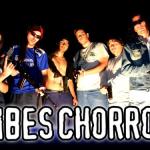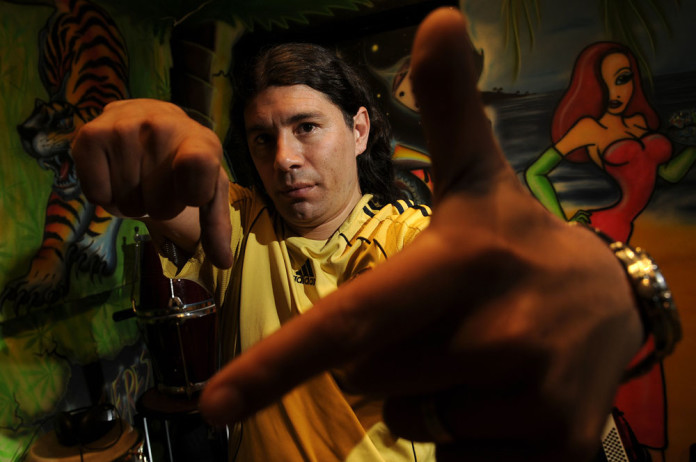Surely if you have spent some time in Buenos Aires you have encountered your fair share of Boliches. Regardless of your taste in music, we have all found ourselves in the wee hours of the morning cutting a rug to some serious reggaeton and electronic cumbia. It is some sort of late night rite of passage that every Buenos Aires resident or visitor must go through. In the midst of those late nights you will dance to, without fail, a number of cumbia villeras. Cumbia villera is a type of cumbia that was born here in Buenos Aires and has since been commercially produced spread throughout Latin-America. Ever wonder about the story behind cumbia villera? No? Well, that’s OK I will tell you anyway….
Villeros
You can pick out a cumbia villera by its lo-fi, low quality sounding electronic instruments (so many keytars…) and lyrics that often refer to drugs, sex, and various other ¨delinquent¨ topics. At a glance it is easy to dismiss this genre of music, and many people have as a low class, vapid attempt at cumbia. However, cumbia villera is surprisingly much more complex than one might initially assume.
¨Villera¨ refers to a subculture of people that are from villas miserias. Villas miserias are shantytowns that have popped up and grown in Buenos Aires since the 1940s. Although Argentina is one of the most economically developed countries in Latin-America, its wealth disparity is particularly evident in urban areas and clearly demonstrated in the numerous villas that exist in and around the city. The most famous is probably Villa 31 because it is located in Retiro, a wealthier neighborhood of the Capital. In the last 20 years villas have grown faster than ever. It is difficult for the city to get exact numbers but roughly 10% of the Buenos Aires population lives in villas. Wow, right? Villas were originally comprised Bolivians, Peruvians, and Paraguayans, along with people who moved into the city from the north of Argentina.
What it’s like
Staying true to their name, conditions in these villas are not fun. Because they  are not considered to be formal neighborhoods, they are not served by any of the city’s services that we so often take for granted i.e. electricity, water, garbage treatment etc. Their narrow streets make it extremely difficult for emergency assistance to reach the villas. Social stigmas are not forgiving to those that grew up in the villas and
are not considered to be formal neighborhoods, they are not served by any of the city’s services that we so often take for granted i.e. electricity, water, garbage treatment etc. Their narrow streets make it extremely difficult for emergency assistance to reach the villas. Social stigmas are not forgiving to those that grew up in the villas and
the stark separation between the villas and the rest of Buenos Aires creates a cultural divide that makes villeros stick out like a sore thumb when engaging with the larger Buenos Aires. Villas are also now home to second and third generation families which, perhaps, says something about how easy it is to leave a villa…especially if you were born there.
When life gives you lemons…
Like most milestones in musical evolution (gospel, blues,  rap, punk etc. etc.), cumbia villera came to exist in an environment of social and economic oppression. There is a huge amount of prejudice associated with all aspects of villero culture. From style of dress to the dialect, anything associated with the villas are often quickly dismissed as negative and low class. Just like any other subculture, people that live in villas are accustomed to their own culture and feel a source of pride in those same things that make them stand out. Much like the above mentioned genres of music, cumbia villera reclaims the very aspects of villero culture that are rejected by the rest of the city. You can hear a huge range of influences from music from the immigrant populations that populate the villas: cumbia (obviously), cuarteto, chamamé as well as from rebellious genres with which the genre identifies: rock, rap, reggae etc. Those essential lo-fi electronic instruments have poor sound quality because they are cheap. It is what can be afforded by someone living in a villa. Just the same, when these musicians make it big they carry on with the same instruments because they are representative of the culture of that they came from. The lyrics dedicated to sex, drugs, and crime serve as a testimony to the experiences of people that grow up there and brings those stories to the masses. The mixture of styles and influences come together to create a makeshift style of music that is,in a sense, the auditory manifestation of the shantytowns themselves. In no time people all over Latin America are singing along and dancing to the culture that they simultaneously reject.
rap, punk etc. etc.), cumbia villera came to exist in an environment of social and economic oppression. There is a huge amount of prejudice associated with all aspects of villero culture. From style of dress to the dialect, anything associated with the villas are often quickly dismissed as negative and low class. Just like any other subculture, people that live in villas are accustomed to their own culture and feel a source of pride in those same things that make them stand out. Much like the above mentioned genres of music, cumbia villera reclaims the very aspects of villero culture that are rejected by the rest of the city. You can hear a huge range of influences from music from the immigrant populations that populate the villas: cumbia (obviously), cuarteto, chamamé as well as from rebellious genres with which the genre identifies: rock, rap, reggae etc. Those essential lo-fi electronic instruments have poor sound quality because they are cheap. It is what can be afforded by someone living in a villa. Just the same, when these musicians make it big they carry on with the same instruments because they are representative of the culture of that they came from. The lyrics dedicated to sex, drugs, and crime serve as a testimony to the experiences of people that grow up there and brings those stories to the masses. The mixture of styles and influences come together to create a makeshift style of music that is,in a sense, the auditory manifestation of the shantytowns themselves. In no time people all over Latin America are singing along and dancing to the culture that they simultaneously reject.
¨Gardel with an electric guitar¨
When talking talk about villero pride we must discuss Pablo Lescanso. Pablo Lescanso is the godfather of cumbia villera and claims to be like Gardel with an electric guitar. That statement might be a bit of a stretch but he essentially started the genre with his band Damas Gratis. He grew up in a villa and although he has certainly earned enough from his music he continues to live in the Villa that he comes from. He explained in an interview, ¨I didn’t move. I am still living in the same house across for Carrefour on 202 in the Villa del Carmen, where I have my PC with Pro Tools and we get together to record or los pibes come over o play playstation. And then there is the house where my mom lives in La Esperanza where she stays alone with my sister Romina. I am a little bit on both sides.¨
In his music he gives testimony to his experience in the villa. He has since kicked the habit but when he was in his teens he became addicted to Paco, a super cheap cocaine paste that is rampant in the villas. Some lyrics are more explicitly speaking to social inequality and others, perhaps unintentionally, give a glimpse into day to day life. In an interview Lescanso said, ¨look, I want to represent what I see and what they tell me on the street. And I’ll tell you something, I come to the Capital and they tell me that there are more drugs there than in the villa near my house. There they live in a different world. There many still play with marbles and trash pick with horse drawn carts. I sing about when they tell me. Not long ago a cartonero (people who collect cardboard boxes from the trash in order recycle for money) broke my heart because he asked me when I was going to dedicate a song to them. He also thinks that I am a testimonial, no?¨
(x2)
Now we take the control
We are the owners of the pavillion
We are tired of so much repression
and we are going to play from this prison
I want that everyone to riot
To raise their hands high
And begin to pray
the guards and refugees of this prison uhh ohh ohh (x2)
(x2)
I don’t mind dying
Open this cell for me I want to leave
I don’t mind dying
Open this cell for me I want to leave
Mr. Prison guard
Let me leave
Mr. Prison guard
Let me leave
Inspiring change? Perhaps…
The separation between the villas and the rest of the city goes far deeper than just a cultural divide; there are social and political explanations for why it is so difficult for a villero to get out of poverty. Throughout the rises and falls of political leadership and ideology in Argentina, there have been a number of approaches of how to handle the shantytowns. In the late 1960s the military dictatorship built housing projects with apartments that were even smaller and of lower quality than the housing that people were able to build themselves with found materials. These living situations were intentionally made to be uncomfortable with distorted hopes of inspiring people to move out of the villas. They even physically removed people from the villas by loading them into trucks and dropping them off in the greater Buenos Aires area. They then bulldozed over their homes. They even went so far as to build walls around a villa to avoid the eye sore that they felt it created. In more recent history a dependence on social welfare systems have been developed through soup kitchens and low but regular stipends. Unfortunately the distribution system has become a source of manipulating the villeros in order to gain political support. Although basic subsidies are properly distributed, there are further incentives that are offered in exchange for votes. This makes it extremely difficult for villeros to gain political or social power or voice their opinions.
There have been some positive shifts in the approach to improving conditions in the shantytowns. In the last 15 years there have been moves in legislation to urbanize the shantytowns; a shift in ideology that began to occur around the same time that villa cumbiera began to be commercially produced. These changes have proven to move extremely slowly, if at all, but the idea is to improve the infrastructure with the distant goal of eventually recognizing the villas as neighborhoods. It is not so easy, though, In order to formalize neighborhoods living situations need to be considered ¨up to code¨. If the city recognizes these neighborhoods as formal neighborhoods, they then have to recognize the home owners. In doing so, those homeowners would then be expected to pay taxes which imply that the living conditions in those neighborhoods meet basic living standards.
Although the conditions inside the villa are rough, the prejudice outside of the villas leaves little motivation to want to leave. The cultural divide is a huge hurdle integrating the villas into the rest of the city. In 2013 the city did collaborate with the community to build a cultural center in Villa 21 in an effort to begin to bridge the cultural divide. The villas themselves have also collaborated with the city government to organize organized locally elected ‘Participative Committees’ to represent the villas in a way that is recognized by the government. There have also been efforts within the villas to organize and pool money in order to improve conditions. Tiny steps in the right direction.
Needless to say, it is incredibly complex to discuss the villas. It seems that the further you dissect the history and potential future of the villas, the more difficult it becomes to come to any conclusions. At the very least, the next time you making an attempt at dancing cumbia at 3am in a club, instead of considering those cumbia villeras as empty sources of entertainment, we can recognize them as steps towards mending a cultural divide while somehow maintaining an irresistible catchiness that we have all enjoyed a time or two.




